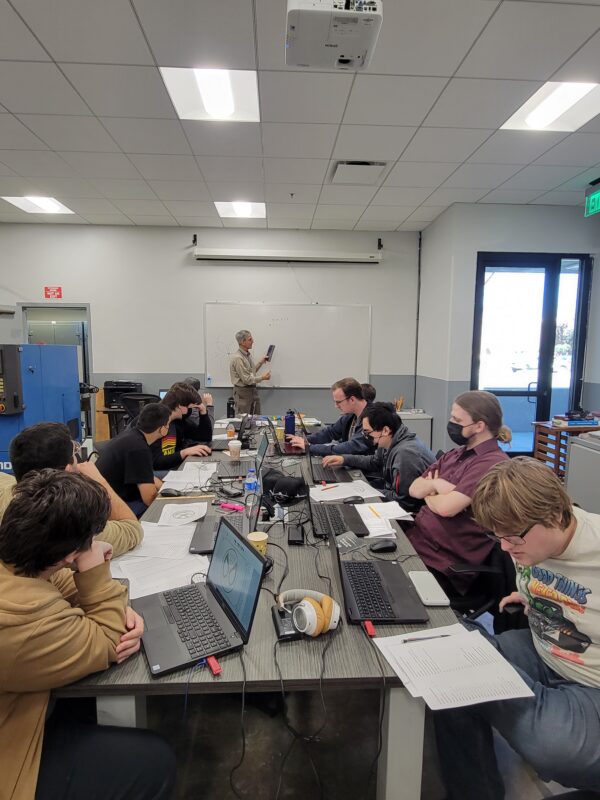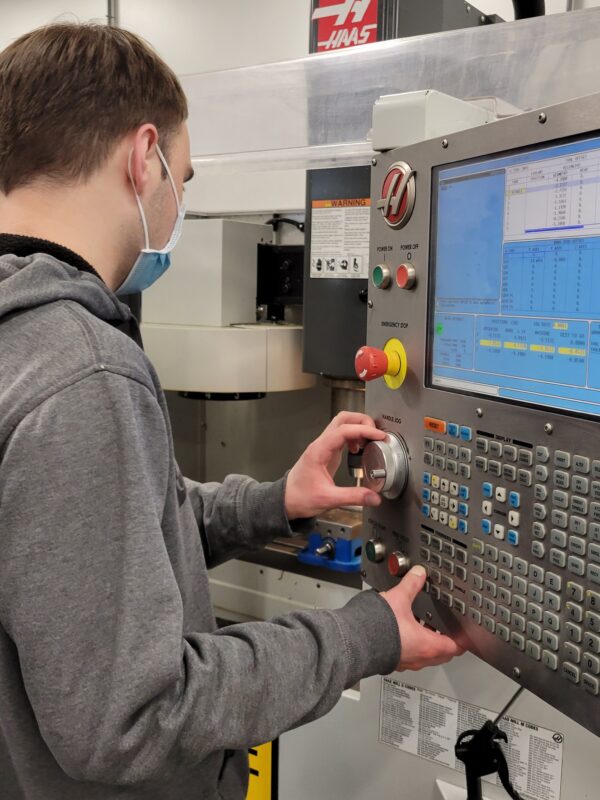By Sarah Sikandar
Signal Staff Writer
Matt Ortiz, 19, loves soccer and is a Lionel Messi fan. Of late, however, he’s been getting less time for his favorite sport as his focus shifted to his first job with TA Aerospace as a molder in Santa Clarita. He is one of the ten graduates from Uniquely Abled Academy’s 2022 cohort at College of the Canyons.
A public-private partnership, UAA is a collaborative program between COC and Jay Nolan Community Services that provides job training to autistic individuals, steering them on the path to independence through employment, mostly in manufacturing jobs, around the Santa Clarita Valley. The program began in 2018, before in-person classes were discontinued because of COVID-19 restrictions.
UAA, jointly funded by the California Department of Rehabilitation, trains and prepares individuals with high-functioning autism for careers as computer numerically controlled machinists. The main goal of the program is to train such individuals with practical skills as well as soft skills to navigate their way through the work environment.
The unemployment rate among autistic individuals is twice that of the general population, according to figures from the Autism Society. Nearly 42% of autistic individuals never work in their 20s and more than 66% of young adults on the spectrum are not employed. According to another independent study from the A.J. Drexel Autism Institute, autism, compared to other intellectual disabilities, has the lowest percentage of young adults who have ever worked.
Ivan Rosenberg, founder and president of the Uniquely Abled Project, the overreaching concept behind UAA, is a marketing consultant and father to two autistic children. “We parents have to shift from looking at our kids as disabled. I thought about 40 million people who would love to have a job. On the other hand, we have millions of companies that want to hire, and that’s what started the uniquely abled program.”
In the 2022 cohort, nine out of ten participants are employed, Karen Navarro said, beaming with pride. Navarro is a career project coordinator with Jay Nolan Community Services, a California-based organization that offers training, employment services and family support through various programs. UAA is more than a job for her, since she’s involved with the program beyond the classroom.
“It all started with different kinds of people coming together and talking about the parameters needed to make a program like this work and be successful from beginning to end,” she said. When they started, “one of our biggest fears was job placement, which, really, is the basic goal of the program.”
This is where COC comes in.
John Milburn, COC’s interim vice president of workforce and economic advancement, said the jobs involved require precision. “It’s very important that things are done correctly into high-precision aerospace, medical device manufacturing. It’s not something to be taken lightly.”
Most of the employers in Santa Clarita, he added, are world-class manufacturers with intense protocols. COC instructors and lab assistants work with these students to make sure the classroom is oriented to their needs and aptitude.

“We had to think about an instructor with ten students with special needs. The instructors are very experienced in teaching machines, but not with this population of individuals.” He said COC has a relationship with employers enhanced through job fairs, and this was what UAA students were able to take advantage of.
Navarro juggles communicating with potential employers and working with the students and instructors to make sure the program runs smoothly, and everyone gets what they need. A longtime Santa Clarita resident, she knew that the city is home to many manufacturing companies. “I know that we have a robust industrial center. I got a big Excel spreadsheet, and I start calling people.”
She also ensures that employers understand that they’re hiring trained individuals. “I’m not here to say, ‘Please help these people and just put them in your workforce.’ I’m here to say, ‘They’ve been trained, and they are going to fit your business model, let me know where you have a need for.’”
David Fletcher, 26, a UAA graduate, was hired by Classic Wire Cut, which mainly manufactures military and medical equipment. He didn’t know what to expect from the program when he came in. He previously worked in customer service.
“I wanted to get out of customer service because I didn’t like working or dealing with customers.” Fletcher pointed out the uncertainty in the beginning, which eased through various tools available within the UAA program.
“I didn’t know if I would be good at it. I’d never done anything like it before. Every Friday throughout the program, we had soft skills with Karen.”
Fletcher said that aspect of his training helped him understand different aspects of searching for and holding down a job.

Navarro cited the circle of support, involving families and parents, which makes the program work.
Ortiz’s maternal grandfather, who also works with a manufacturing company in Burbank, helped him understand the process. “He would talk to me and tell me that it would be nervous a few days and I need to get adjusted to it,” he said.
Ortiz’s mother, Raquel Ortiz, has a younger son, also on the spectrum. She calls UAA a salvation for herself and her family. Matt was home before he entered the program, dreaming of soccer, she said. The program, she added, has helped him understand the importance of earning and living independently.
“It’s been a daily struggle, but the reward is great. I know he wouldn’t be able to get a job without this program. He asked his father to quit his second job because he can help now.”
Rosenberg said UAA is a seamless project. “From the day a kid sees a flyer for an open house, all through the training and finding a job, and transitioning to the day that job starts, UAA is a no-brainer.”
“These guys looked like a million bucks on their graduation,” Milburn said. He said that during the job fair, which includes speed interviews, the college’s relationship with employers also helped.
UAA’s success, in terms of job placement, is unprecedented in 2022. The first couple of cohorts had a lower rate of hiring. This year, however, all eight students from the program have been successfully hired.








